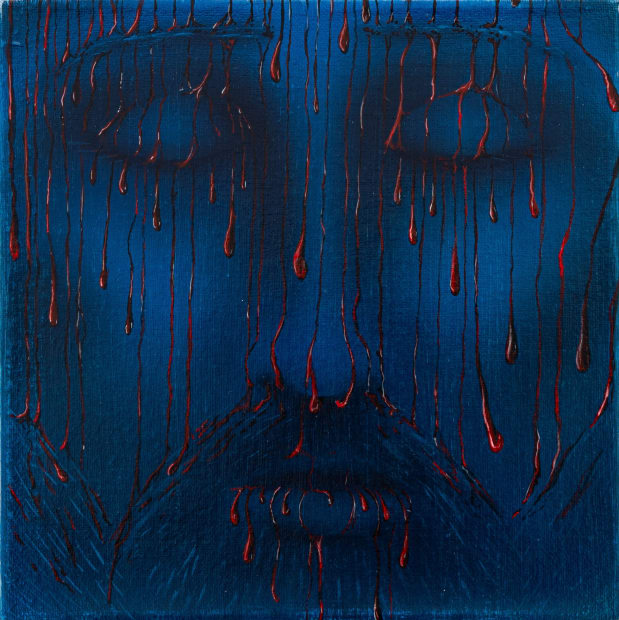-
Filippo A.L. Cegani's solo exhibition embarks on a journey into the artist's exploration of Christianity and its iconography within today's modern context. Cegani’s practice initially started with a post-digital approach in his paintings and finally developed into merging of classical and contemporary aesthetics in his compositions.
While religious iconography traditionally resides in museums and places of worship, it has also become a part of the digital era, which has been integrated in our current world. The immediate availability, accessibility, and reproducibility give a platform for religious imagery to reach a larger audience. However, this accessibility often results in distortion, with religious figures being appropriated into memes, jokes, or even T-shirt designs. The process of digitalizing and ironizing something that, for so many, is holy contributes to the loss of value of said figures. Famous quotes of saints and martyrs can be found badly photoshopped on classical paintings or representations of said figures, which, in turn, simplifies both the message and the concept.
-
 You either cry here or there, Installation View, 2024
You either cry here or there, Installation View, 2024 -
"Also, given the title of the show, which was what my father used to tell me when I was a child, it kind of meant that wherever you go, whatever you do, you always cry. And it was meant as a joke. I think it also reflects a lot on Italian culture and the way I was brought up. Therefore, within the pain, you find irony and comedy."
- Filippo A.L. Cegani
-
Artist Backround
 Filippo A.L. Cegani in his studio.
Filippo A.L. Cegani in his studio. -
What lies beneath
-
Terrible is the justice of God
 Terrible is the justice of God, 2023, acrylics on canvas, 70 x 50 cm
Terrible is the justice of God, 2023, acrylics on canvas, 70 x 50 cm -
Terrible is the justice of God depicts Italian priest Pio of Pietrelcina (1887–1968), widely known as Padre Pio. Padre Pio is greatly idealized in Southern Italy, and in fact, he gained mass popularity in Naples. In addition, he was one of the last classical saints.
Padre Pio has stated some controversial opinions in his lifetime, one of them being: “Terrible is the justice of God,” which reflected a medieval vibe compared to what the Christian church wanted to portray at that time. Cegani stated:
I go to the Christian blogs and just find these sentences. I think that if you digest the sentences as if they don't matter, they actually don't. But people take it seriously. It's like a new age Leviticus, under a certain point of view. I don't see him as a negative figure in the first place. I just think how he is framed on digital platforms could become dangerous. At the same time, I don't see him as a dangerous figure, either. I just think how his portrait is in a digital atmosphere would lead to weird scenarios like a fundamentalist view. I think you should take religion from a distance and with your own self-thoughts. But given a sentence of that sort, as in “Terrible is the justice of God”, I just find it quite interesting because justice should be justice, and it can't be terrible.
-
Silver Cages
 Silver Cages, 2024, acrylics on canvas, 70 x 50 cm
Silver Cages, 2024, acrylics on canvas, 70 x 50 cm -
Lady of Sorrows
 Lady of Sorrows, 2023, acrylics on canvas, 50 x 40 cm
Lady of Sorrows, 2023, acrylics on canvas, 50 x 40 cm -
Temptations
 Temptation, 2024, acrylics on canvas, 40 x 50 cm
Temptation, 2024, acrylics on canvas, 40 x 50 cm -
Blue Sindone
 Blue Sindone, 2024, acrylics on canvas, 25 x 25 cm
Blue Sindone, 2024, acrylics on canvas, 25 x 25 cm -
Bedside Painting
 Bedside Painting, 2024, acrylics on canvas, 25 x 25 cm
Bedside Painting, 2024, acrylics on canvas, 25 x 25 cm -
-
For enquiries into the works by Filippo A.L. Cegani, please click on the button below:
Filippo A. L. Cegani, 20 April - 25 May
Stay in touch with Enari
Joining the Enari newsletter is the best way to stay informed about our latest shows, fairs, and artists' news
* denotes required fields
We will process the personal data you have supplied to communicate with you in accordance with our Privacy Policy. You can unsubscribe or change your preferences at any time by clicking the link in our emails.









